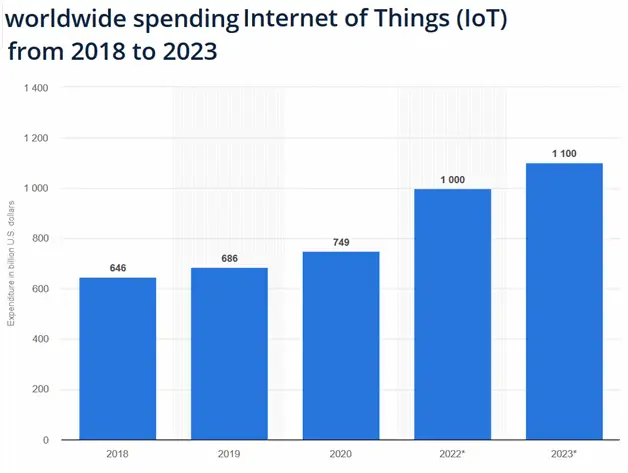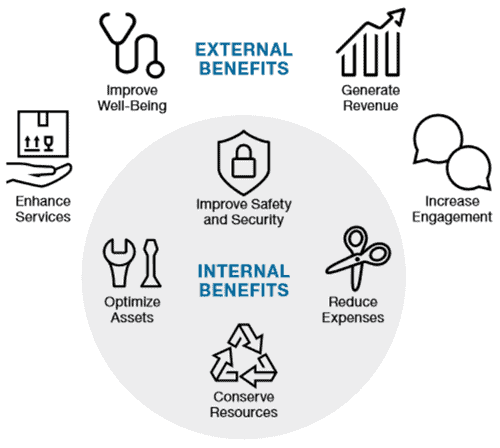IoT devices raising the bar in Supply Chain systems
Introduction
IoT, internet of things, comprises of an interconnected network of primarily electrical appliances that “talk” through the web. Devices include (e.g., lightbulbs, thermostats, or smart speakers like Alexa). These appliances are equipped with sensors, software, and connectivity technologies. The sensors act as loggers that pick up data about a particular aspect and store it for further processing. The preloaded software uses the onboard hardware to store and process the data generated by the sensors. The IoT Device manufacturers use communications tech may be a Bluetooth transmitter or a Wi-Fi modem, etc. They help the appliance contact other devices on the network.
IoT at work in homes and elsewhere
With the advent of Virtual Digital Assistants, almost all electrical appliances present in our homes turn ‘Smart’. This has led to the movement of Home Automation. Which ultimately aims to bring efficiency, savings, and optimum utilization of resources. The energy-consuming appliances used for lighting, heating, and air conditioning can now be smart enough to reduce electricity bills. Smart security CCTV cameras can keep our homes safe. Media devices like smart screens eliminate the use of multiple devices as they offer an all-in-one experience. The pre-installed Apple Siri, Amazon Echo, and Google Assistant applications can easily allow users to set commands or ‘rules’ for the devices. Smart medical devices keep our health under check and inform healthcare professionals when in need of emergency assistance.
As medical and healthcare systems continue to intensify their use of technology, IoT of medical things are the obvious choice. Health monitoring devices like Blood pressure and heart rate monitors are the most simple devices that can now interface with other devices. The availability of smart bands and smartwatches has allowed us to monitor our health routines on our smartphones. Hospitals have intelligent beds, smart IV machines, and so on. A report by Goldman Sachs in 2015 highlighted that healthcare IoT i.e., Medical things, has the capability to enable the US about $300 billion through optimal use.
Emergence of IoT
Spending patterns on IoT are evident in the speeded emergence of new trends. In 2018, there were close to 11 billion IoT devices, equally divided into consumer and commercial segments. A number that is expected to touch a user base of 21.5 billion units by 2025. The IoT devices, smart devices, and home automation are all combined to reach USD 157 billion by 2023, in the US alone. As smart devices clump up to make smart homes, intelligent homes into smart cities, these trends are expected to continue undeterred.
https://www.statista.com/statistics/668996/worldwide-expenditures-for-the-internet-of-things/
What services IoT companies provide
As IoT has several different applications, the companies involved in the business offer a plethora of services. Major IoT services provided by top IoT device manufacturing company include:
- IoT Application Development,
- IoT Analytics,
- IoT Consulting Services
- Cloud Applications (user and control apps),
- IoT Data Analytics
- Mobile User Applications
- IoT Architecture
- Industrial IoT
- IoT Software Development
- IoT Hardware Prototyping
- IoT Integration Services
- IoT services for Mobile, Web, Data, and Embedded levels
The prominent names in IoT Device Manufacturers, in no particular order, include
- ScienceSoft (USA & Europe)
- Oxagile (New York, US)
- Style Lab IoT Software Company (San Francisco, CA)
- HQ Software Industrial IoT Company (USA & Europe)
- PTC (Boston, Massachusetts)
- Cisco (San Jose, CA)
- ARM IoT Security Company (Cambridge, Cambs)
- Huawei (Shenzhen, Guangdong)
- GE Digital (San Ramon, California)
- Bosch IoT Sensor Company (Farmington Hills, MI)
- SAP (Walldorf, Germany)
- Siemens IoT Analytics Company (Berlin and Munich, Germany)
- IBM (New York, U.S.)
Supply chain Connected Devices
An IoT device manufacturer companies would help with IoT-based and IoT-driven transport systems. They address challenges in transportation and logistics. A prominent example here would be an IoT based smart transportation system. The best IoT companies in the world have brought about a revolutionary change in transport facilities. It starts from a simple application where your smart vehicle knows when you are done with your morning routine and are ready to drive to work. By the time you go to your car, it is prepared for you. A connected car would send its self diagnostics data to the manufacturer through the diagnostic bus. Information from sensors can help manufacturers improve the product development. And at the same time tell you when it is time to take it for a Service. If a part is about to go wrong, your nearest service center will have it stocked for you before you book the appointment. A connected car will help you navigate to the service center. And the manufacturer can push product software updates on-the-air as and when new features come in.
Fleet management using IoT is another tremendous application. Logistics operators know the mechanical health of their fleet and plan for scheduled maintenances accordingly.
One of the most revolutionary applications of supply chain connected devices is in the education sector. As more and more schools adopt new technologies, it helps them spread the light of education in the most innovative ways.
Globally the supply chain systems have grown more and more complex every passing year. As a whole, the supply chain has transformed into a larger ecosystem on smaller systems, where each of the smaller systems is dedicated to suppliers, logistics companies, and customers. A synchronized movement of goods is the key to an efficient supply chain. The efficiency should address customer needs through the use of innovative products and solutions. A World Economic Forum article informs that globally, there are close to 3 Trillion consumer products that are manufactured and shipped. The biggest challenge here is the end to end traceability.
https://www.gartner.com/imagesrv/books/iot/iotEbook_digital.pdf
A connected supply chain solution
As global supply chains constituting different ecosystems integrate and inter-twine, the complexity takes a big jump. The purpose of a connected supply chain is to connect every stakeholder in the supply chain. Integrating different systems and empowering them with IoT. This will enable a free flow of information from one end to the other. This flow of information will give complete transparency and visibility, perhaps in real-time. Stakeholders like dealers, manufacturers, suppliers, logistics partners, and customers are all well informed and enabled to make informed decisions.
The system should not only aim at achieving total visibility and integration. Instead offer them through one, well connected, and integrated approach. Devices talking to each other via the internet, sharing data and insights is the perfect scenario. Such a connected supply chain will not only be efficient, but it will also go further to provide responsiveness and resilience. Consumers will be able to predict the arrival of supplies and make amends in real-time.
This can be achieved using different technologies for supply chain connected devices that include but are not limited to – cloud, Internet of Things (IoT), Big data, AI, and machine learning.
Examples of effective implementation of IoT in Supply Chains
- Farm level – Farmers can stay updated with changing soil conditions through use of IoT devices. So they know when it is the right time to act in favor of their crops – plant, cultivate, harvest
- Manufacturers – Use of IoT devices can help remove the stress out of moving goods from one place to other. Intelligent camera systems to point out imperfections in products
- On-time deliveries for logistics service providers. Minimal unexpected breakdowns and maintenances
- Efficient supply chains enabling just in time manufacturing practices especially those involving assembly lines
- Food retailers – know the helth of their food products by monitoring temperature and moisture/humidty levels. Controlled storages rely on these parameters
Security and vulnerability issues
Almost all IoT devices are connected using the wider internet instead of small secluded local area networks. A Gartner report dated 2017 projected that by 2020 there will be 20 billion non-IT devices connected. With the advent of 5G networks, the data-intensive devices can also be onboarded quickly. The 5G’s low-latency and high bandwidth are enablers for augmented reality applications and perhaps self-driving cars too.
With the sudden emergence of this megatrend, keeping these connected devices secure is a big concern. Unless the device connection is secure, it can be overtaken by a hacker. They could simply take control of the device and route its communications to an illegitimate target destination. Once the criminal is in control, the devices and their owners are at the mercy of these criminals.
In another instance, the data from smart devices could be getting collected at a remote server. What happens to the data when there is a DDoS attack on the server. Once the hacker takes it over, they have access to individual users’ personal data, which may be misused. Imagine security cameras around the house, delivering live feeds to a hacker. Or go a step further where the smart speakers and other audio systems are merely sharing the vocals inside the home to a hacker based at a remote location.
The IoT-enabled security devices like cameras, door locks, garage doors, etc. were implemented keeping the internet in mind. Several devices even have data backup being controlled remotely at distant servers. Cloud-based systems do not essentially have to have high processing power locally. Hence the IoT device manufacturing company require less costly devices at the implementation level. The majority of the processing takes place at the removal location. A stronger security support is needed at the network and the cloud level. And manufacturers should push devices updated over secured networks to avoid a hostile takeover by criminals.
Hence the security of IoT devices is a balancing act between device security, privacy, and effectiveness.


